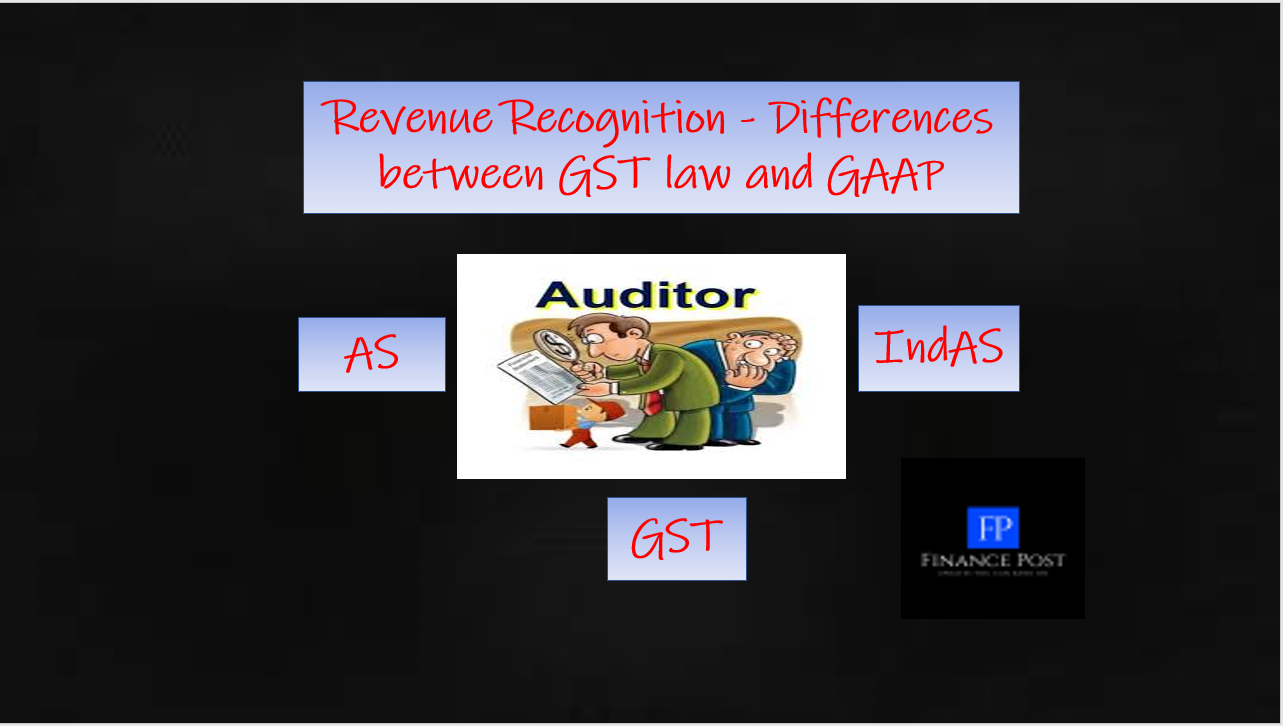
Last updated on May 16th, 2021 at 08:10 pm
GST and Accounting Standards (AS / IndAS) Differences
An accountant or a statutory auditor follows some GAAP for the accounting of the transactions. As mandated by the Companies Act, it can be either Accounting Standards (AS) or IndAS issued by ICAI.
A GST Auditor, while looking into the financial statements of the Company, should first understand the accounting standards applicable to the company. There could be differences in the manner of the accounting and treatment of certain transactions as per Accounting Standard in the financial statements vis-à-vis the treatment under GST. This can lead to reporting of a different number of turnover as per GST law and in audited accounts.
For Example:
As per GST Law, in the case of an agent, turnover of the principal is also treated as the revenue of the Agent. On the other hand, as the accounting treatment goes, only the commission earned is shown as the revenue of the agent, and supplies on behalf of the principal are not reflected in the financial statements of the agent.
Different exchange rates are used for the supply of goods for paying tax under the GST regime and in accounting valuation. This can be one of the reasons for turnover differences in GSTR 9C between financial statements and GSTR 9.
There are many such differences and we aim to provide some significant differences below:
Accounting for Leases (AS 19):
As per the Accounting Standard, in the case of a lessee, the number of lease rentals would be bifurcated into interest charges and liability, whereas under the GST, the entire amount would be treated as an expense.
In the case of the lessor, only the finance charges would be treated as revenue as per the AS, whereas under the GST, the entire amount would be treated as revenue.
Under Accounting Standard 19 in the case of a finance lease, the Lessor will account for the cost of the asset as a receivable whereas, in the books of the lessee, it would be recorded as an asset purchased. On the other hand, under the GST, the cost of the asset would be recorded as a purchase and the fair value of the asset would not be recorded in the books of the lessee as a purchase.
AS 1/Ind AS 1: Disclosure of Accounting Policies:
AS 1 deal with the disclosure of significant accounting policies followed in the preparation and presentation of financial statements. Currently, the accounting for different indirect taxes is done on the basis of their nature and point of the levy. Under IND AS, excise duty is included in revenue, since it is a (manufacture) production-based tax. GST is not included in revenue, because it is levied at the time of sales. GST is levied at the point of supply as it is a destination-based tax. Hence, the revenue might not be presented including GST.
Comparative Numbers: For the first three months of 2017-18 revenue should be presented at Gross for Excise Less Excise Duty paid, and for the subsequent period, it would be shown only Net, which would bring some distortion in the reading of the numbers for the users as the comparative for the previous years would be different.
AS 2/IND AS2 Valuation of Inventory:
As per AS-2, the costs of purchase of inventories comprise the purchase price, import duties, and other taxes and transport, handling, and other costs directly attributable to the acquisition of finished goods, materials, and services. Trade discounts, rebates, etc are deducted in determining the costs of purchase. However, the CGST Act and the corresponding SGST / UTGST Act provide for the availment of input tax credit or refund of the input tax credit in specified situations. Thus, to the extent credit is availed or refund is claimed, it would not form part of the cost of inventory.
At the same time, the auditor should note that input tax credit is not available in some situations like (a) Input /input services /capital goods are used for personal purposes; (b) Tax paid under Section 10 (c) Restricted credits (d) Depreciation claimed on tax portion/element; (e) Input/input services/capital goods used for exempted supply. Hence, the auditor should evaluate “what” credit is claimed and “what is” part of the cost of inventory as per the applicable accounting standard
AS 9/Ind AS 115: Revenue Reconciliations Revenue recognition
As per AS, Revenue is recognized either when the control is obtained by the customer over the promised service or it can be apportioned over a period of time of the promised service. As per GST, Revenue is recognized either at the time of supply or at the time of payment (whichever is earlier).
The definition of Revenue as per Accounting Standards may not coincide with turnover for the purpose of GST. For example, in the case of multiple element contracts, total consideration would be allocated to each component based on the fair value of each element. However, this method cannot be used for GST purposes.
Click here to know more differences between the Revenue Recognition standard and GST Law.
AS 10 / Ind AS 16: Accounting for Fixed Assets / Property, Plant and Equipment
The definition of Fixed Asset and related accounting is relatively different under AS and IndAS as well as GST.
[su_table]
| Accounting Standard 10: Accounting for Fixed Assets | Ind As 16: Property, Plant and Equipment | Fixed Assets: From the GST Perspective |
| The cost of FA comprises its purchase price plus import duties and other non-refundable taxes or levies and any directly attributable cost of bringing the asset to its working condition for its intended use. | The cost of Fixed Assets is the amount of cash or cash equipment paid or the fair value of the other consideration given to acquire an asset at the time of its acquisition or construction | The input tax credit shall not be allowed on the tax component of the cost of capital goods and plant and machinery if depreciation on such tax component has been claimed for tax purposes. |
[/su_table]
AS-11 / Ind AS 21: Treatment of exchange differences
GST law in Rule 34 of CGST, specifically mentions the rate of exchange to be used to determine the value of taxable goods and services. It is interesting to note that the conversion rate to be applied is different for “goods” and “Services” as per the GST Law. For the purpose of conversion of Indian currency into foreign currency or foreign currency into Indian currency while computing value of “Goods”, rates notified by the Board need to be considered. CBIC issues notifications from time to time in this regard. The rate of exchange for determining the value of “taxable services” shall be the applicable rate of exchange determined as per the GAAP for the date or time of supply of such services.
- AS 11 on the other hand, allows different exchange rates or average rates for conversion of goods while computing turnover. For Balance sheet conversion, Closing rates are applied. As a result, the exchange differences arising on translation are accounted for either as income or expenses. There is no such impact in GST.
- IndAS 21 mentions treatment for the conversion of turnover, similar to AS 11. However, there are many complex provisions and treatments which are not addressed in GST Law.
Hence, different exchange rates may be applied for the supply of goods for paying tax under the GST regime and in accounting valuation.
AS 12/Ind AS 20: Accounting for Government Grants
Government Grant Assistance can be considered as Revenue as per accounting standards. However, under the GST Laws, as per “the value of supply shall include subsidies directly linked to the price excluding subsidies provided by the Central Government and State Governments”. (Refer Sec 15(2) (e) of the CGST Act ). Accordingly, Govt. grants are not considered as revenue as per GST law.
AS-29 / Ind AS 37: Provisions, contingent liabilities and assets
As per accounting standards, Contingent liabilities are recognized only if there are uncertainties about the outflows but not about the existence of an obligation. Else, contingent liabilities appear as notes to the financial statements. Contingent assets are not recognized in the balance sheet. For eg., A guarantee is given to the client, banker etc.
A provision is a ‘best estimate’ of the expenditure to be incurred. Provisions may be required to make in financials in terms of Ind AS 37 for Warranty and replacements.
If a warranty is given with the supply of any goods or services, it shall be treated as a composite supply of the original supply. However, GST would be applicable on the warranty amount if the same is recovered from the customer.
Conclusion:
There are many such differences that a company or an auditor will come across. The above-mentioned list is illustrative and practical difficulties might crop up while auditing. Hence, as a GST auditor or as an accountant, one should always bear in mind the different accounting rules and applicability of GST Law.
- How to do a transaction in Digital Rupee (CBDC-R)? – A Step by step Guide - 10/12/2022
- Can you rectify your 26AS? - 20/09/2022
- Tax implications on Cashback - 09/09/2022
Disclaimer: The above content is for general info purpose only and does not constitute professional advice. The author/ website will not be liable for any inaccurate / incomplete information and any reliance you place on the content is strictly at your risk.
Follow us on Social Media by clicking below
Follow @financepost_in


??
Very Informative.. !
Please keep sharing informative post
Thanks for the comment Mr. Thakkar.
Very good article. Keep generating good stuff.
Thanks Mr. Manan V
A1
Thank you